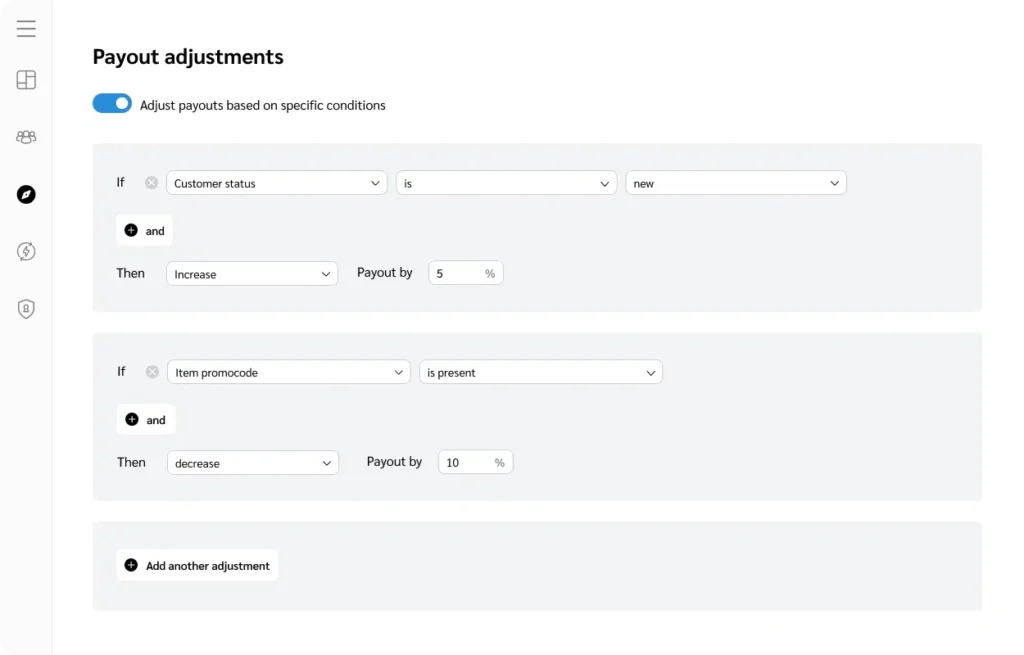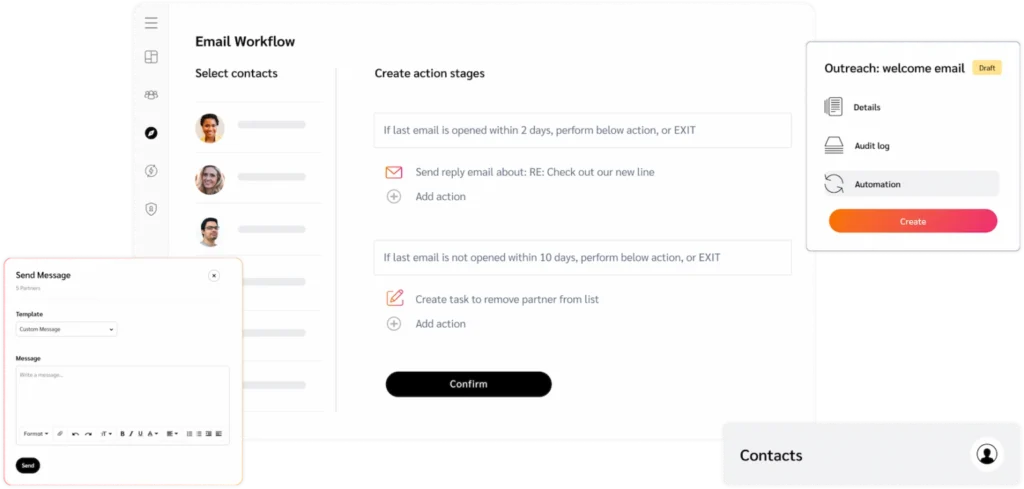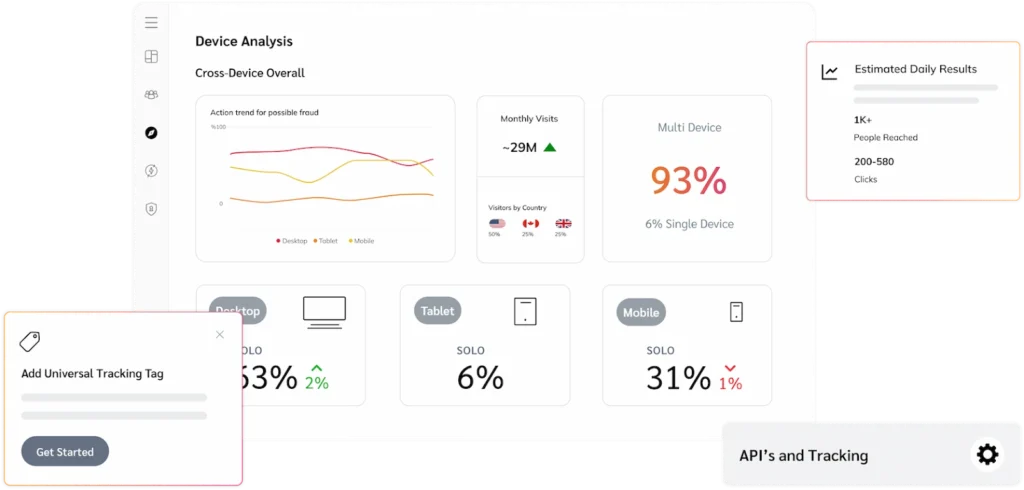At its core, affiliate marketing is a strategy where brands reward partners for driving traffic, leads, or sales to their websites. This model ensures that every dollar spent delivers measurable results, making it a marketer’s favorite. The remarkable growth in this sector—a growing industry of $9.1 billion—underscores its effectiveness and continued popularity.
As businesses grapple with high advertising costs, the diminishing returns of cookie-dependent marketing, and the consumer’s desire for authenticity, affiliate marketing emerges as a beacon of opportunity. By leveraging affiliate partnerships, brands can spread their marketing budget across dozens or hundreds of affiliates. Each affiliate partner brings a unique touch to the brand’s message. This collective effort amplifies the brand’s presence in the marketplace, fostering an environment where authentic recommendations drive customer engagement and sales.
Successful marketers don’t just sign up affiliates and wait for results; they actively engage with their partners, providing the support and resources needed to thrive. From dynamic payout structures that reward top performers to advanced tracking systems that ensure precise attribution, these strategies ensure that every dollar spent drives tangible outcomes.
This comprehensive guide takes a deeper look into the mechanics of affiliate marketing and offers a path to mastering this powerful channel for transformational changes for your brand.
Understanding affiliate marketing: A primer for today’s brands
Affiliate marketing is a performance-based marketing channel where businesses reward partners that drive traffic, leads, or sales to the brand’s website. In an affiliate marketing setup, the main players include:
- The brand creates and sells products or services, providing affiliates with marketing materials to promote these offerings.
- The affiliate partners use various marketing tactics to drive traffic to the brand’s website, earning commissions for sales or leads generated through their unique links.
- The consumer purchases products or services from the brand via affiliate links, completing the transaction that generates commissions for affiliates and revenue for the brand.
Affiliates promote the brand’s products or services to their audience using unique tracking links or discount codes. These links and codes enable the brand to track the affiliate’s referrals and attribute specific conversion events—such as purchases, sign-ups, or downloads—to them.
Upon completing these events, the affiliate earns a commission based on a predetermined payment structure, such as cost per action (CPA), cost per lead (CPL), or cost per click (CPC).
4 undeniable benefits of affiliate marketing
Leading global brands already harness the perks of affiliate marketing. Cozy Earth, the world’s foremost source of high-quality bamboo bed linens, sleepwear, and loungewear, optimized its affiliate program and diversified its affiliate partner mix to yield impressive results. The company gained a 912:1 return on investment, increased online traffic by 92 percent, and brought in 55 percent of revenue through content partners.
Here’s why more brands like Cozy Earth are leaning into the potential of affiliate marketing for sustained growth.
1. Provides cost-effective marketing opportunities
Unlike traditional advertising methods, which require large investments in ad space or media buys, affiliate marketing operates on a performance-based model.

Furthermore, it mitigates financial risk, allowing marketers to allocate resources more efficiently. Commission highly motivates affiliate partners to optimize their efforts, resulting in higher conversion rates and increased sales.
Affiliate marketing reduces marketing expenses and fosters a network of dedicated partners committed to driving the brand’s success by providing a mutually beneficial arrangement.
2. Builds brand trust through authentic recommendations
Modern consumers increasingly seek reliable recommendations and authentic interactions when making purchasing decisions. They turn to friends, influencers, and publishers who share their direct experiences with products and services. This shift from traditional brand communications places a premium on trust and personal endorsements.

Consumers are more likely to perceive affiliate partner endorsements as credible and trustworthy than a standard advertisement. This secondhand trust significantly enhances the brand’s credibility and strengthens connections with potential customers.
3. Enhances brand recognition
By investing in affiliate partnerships, brands can simultaneously amplify their message across multiple channels. Your product or service is mentioned across multiple platforms and channels, increasing your brand’s visibility and recognition.
Over time, this repeated exposure helps build a strong brand presence in the market, ensuring your brand comes to mind when consumers think of a particular product or service. This mass exposure is particularly effective in crowded markets where standing out is crucial.

For instance, a campaign where several popular bloggers and social media influencers promote a new product can generate widespread visibility, making the brand more recognizable to a broader audience.
4. Introduces your brand to niche audiences
Affiliate marketing leverages the unique and tailored platforms of affiliates who have already established a presence within specific, often hard-to-reach niches. These affiliates possess in-depth knowledge of their audience’s preferences, habits, and values, broadcasting your message widely with precise targeting.

This targeted outreach introduces your products or services to potential customers likely to show interest and convert, given their pre-existing engagement with the affiliate’s content.
Expanding reach into niche markets also fosters ongoing brand awareness and loyalty. As these communities become familiar with your brand through trusted affiliates, they are more inclined to view your offerings as credible and relevant, paving the way for long-term customer relationships. Therefore, affiliate marketing drives sustained growth and deepens customer connections.
Affiliate marketing managers: 5 tactics to help you excel
Affiliate managers play a role in driving growth through affiliate marketing programs. Acting as the linchpin between a brand and its affiliate partners, they ensure that campaigns align with its overarching marketing goals. Their responsibilities increase reach, drive conversions, and ultimately boost revenue by managing and optimizing affiliate relationships.
Success in this role depends on a multifaceted skill set, which is needed to ensure that affiliate programs run smoothly and achieve desired outcomes.
- Analytical skills: Ability to interpret data and refine strategies.
- Business acumen: Understanding market dynamics and making informed decisions.
- Organizational skills: Managing multiple partnerships and campaigns simultaneously.
- Interpersonal skills: Fostering relationships and providing support to affiliates.
- Communication skills: Conveying objectives and expectations to partners.
- Technical proficiency: Understanding and utilizing tracking and reporting tools.
- Problem-solving skills: Addressing challenges and optimizing program performance.
- Negotiation skills: Securing favorable terms and agreements with partners.
- Creativity: Developing innovative strategies to engage and motivate affiliates.
- Attention to detail: Ensuring accuracy in tracking, reporting, and communications.
Combining these skills with the following winning tactics creates a robust framework for scalable, effective affiliate marketing.
1. Use a variety of affiliate partners to support the entire customer journey
Affiliate marketing offers brands various partners, each tailored for different customer journey stages. A diverse pool of affiliate partners amplifies brand reach, educates potential customers, and converts those on the fence.
For instance, strategic B2B partners are effective during the awareness and consideration stages, while influencers and creators excel in driving awareness and education. Review and comparison sites help validate and consideration, while loyalty and rewards programs encourage purchases, making them ideal for the consideration and validation stages.

When affiliates are well-matched with the brand’s values, products, and target audience, they offer valuable advantages.
- Provide more authentic endorsements, enhancing trust and customer engagement.
- Facilitates cohesive brand message across various platforms, strengthening brand identity.
- Streamlines collaboration and communication, maximizing the impact of marketing efforts.
Guidelines to find perfectly-aligned affiliate partners—from keyword research to affiliate marketplaces:
Brands must proactively seek affiliate partners that align with their business goals. To discover and recruit high-quality partners, consider these methods:
- Keyword research: Identify websites ranking for relevant keywords and get your product or service listed in exchange for affiliate commissions. Listicles work well here, such as “best women’s rain jacket” or “best accounting software for small businesses.”
- Social media platforms: Use hashtags and search terms to find relevant content creators.
- Research brands in your industry: Find out which affiliates work with other brands. Exercise caution, though, as some partnerships are unlikely to succeed if a potential partner shows allegiance to a single brand. However, a general review website with multiple competitors will work.
- Industry events and conferences: Attend industry-specific events where you can connect with partners who share your target audience.
- Sponsor affiliate events: Introduce your brand by sponsoring events, speaking, or giving away swag to encourage program sign-ups.
- Affiliate networks and marketplaces: Join an affiliate network or a partnership platform that centralizes the recruitment process by housing various affiliate types. For instance, the impact.com platform includes various useful discovery tools.
- Marketplace lets you filter by category and engagement to help you find relevant partner opportunities.
- Extended Search expands your discovery efforts beyond the platform with popular search engines.
- Recommendations save you time by using machine learning to recommend ideal partners.

2. Negotiate win-win contracts
Effective contract negotiation ensures mutual benefit and long-term success. Affiliates and brands can foster stronger, more productive partnerships by focusing on clear terms, transparent expectations, and fair rewards. Consider the following for successful contract negotiations:
- Define objective: Clearly outline the goals and expectations, including sales targets, brand guidelines, and compliance requirements.
- Specify compensation: Be transparent about the reward structure, payment schedule, and additional incentives to build trust.
- Set performance metrics: Align key performance indicators (KPIs) with the overall objectives and provide a clear framework for evaluating partner contributions.
- Ensure mutual benefits: Affiliates should feel valued for their contributions, while brands should see a tangible return on investment.
- Be adaptable: Market conditions, campaign performance, and business goals can change, requiring agreement flexibility.

They allow brands to adjust commission rates based on specific criteria, such as the type of customer (new vs. returning), the product category, or the affiliate’s performance level.

The flexibility of Dynamic Payouts ensures that rewards align with the value contributed by each affiliate. They also introduce unique benefits:
- Incentivizes high performance by offering higher commissions to top-performing affiliates.
- Encourages affiliates to focus on high-value activities, such as promoting premium products or targeting specific customer segments.
- Fosters loyalty and sustained collaborations by implementing payouts that increase over time for long-term partners.
- Increases customer activity and drives higher sales volumes by adjusting commissions during peak seasons or promotional periods.
The CRM platform HubSpot implemented a three-tier commission structure to motivate affiliates with better compensation for high-quality performance. Ultimately, HubSpot increased affiliate revenue and sign-ups by more than 50 percent.
3. Nurture partner relationships to develop lasting collaborations
Your affiliate program’s success is tied to the strength of affiliate relationships. As the driving force behind any affiliate program, an affiliate’s enthusiasm, motivation, and loyalty significantly impact the program’s performance.

Regular communication, feedback, and recognition can help strengthen an affiliate’s loyalty to your brand, ultimately leading to better performance and higher conversions.
3 practical strategies to foster stronger affiliate collaborations
1. Provide regular updates
Keep affiliates informed about new products, upcoming promotions, and program changes. This will help maintain affiliate interest and provide fresh content for their audience. Scheduled and automated messaging features, such as impact.com’s Newsletters, ensure that affiliates receive timely updates, promotional material, and performance feedback without manual intervention.
2. Offer training and valuable resources
Provide training sessions and educational materials to help affiliates improve their marketing skills and strategies. Well-equipped affiliates are more likely to drive successful campaigns. Give them the tools, content, and information they need to succeed, and regularly update these resources to keep them relevant and useful.
Angela Rollins, Torgula’s former Affiliate Manager, shares her approach to centralizing the content library to ensure consistency and quality in campaign execution: “At Tortuga, we got a lot of affiliate requests for photos and tech specs. So, we created a central hub with product information and high-quality images that all our affiliates could access. This was particularly helpful when seeding affiliates new products before launch.”
Management platforms, such as impact.com, streamline creative and offer management, making it easy to empower affiliates while maintaining brand control.

3. Employ personalization tactics
Personalization transforms standard interactions into meaningful connections that resonate with each partner on a deeper level. Tailoring communication, incentives, and support to each affiliate’s unique needs and preferences enhances their experience and drives superior performance and loyalty.
Affiliates feel valued as unique contributors to your program’s success when they receive personalized emails, recognition of individual milestones, and customized feedback. This approach fosters a sense of belonging and motivates affiliates to invest more effort in promoting the brand.

Additionally, management platforms offer further automatization of the process by segmenting affiliates on various criteria, such as performance level, niche focus, or geographic location, to ensure that the right message reaches the right affiliate at the right time.
4. Use tracking methods that reveal more about your program’s success
Affiliate tracking monitors and manages affiliate activities and performance to measure their contributions to a brand’s affiliate marketing efforts. It uses various technologies and methodologies to attribute sales, leads, or other desired actions to specific affiliates. Accurate affiliate tracking introduces brands to invaluable benefits:
- Ensures that affiliates receive proper credit for their contributions.
- Allows brands to evaluate the effectiveness of their affiliates and campaigns.
- Detects and prevents fraudulent activities within the affiliate network
- Provides data-driven insights to improve strategies and maximize return on investment.
- Builds trust with affiliates through clear and transparent reporting.

Management platforms have built-in tracking capabilities that use various methods to track shoppers’ actions. Methodologies used to track actions include:
- Javascript/first-party cookie tracking places tracking codes—JavaScript tags like impact.com’s Universal Tracking Tag—on every landing page.
- Server-to-server tracking [also called ‘cookieless tracking’] uses APIs to track conversion and click events, and it’s fully compliant with Intelligent Tracking Prevention [ITP].
- FTP tracking uses an FTP server to receive and push tracking data. You capture data about visitors on your website before and after conversion, and store this data in first-party cookies. Then, you’ll create a .CSV file of all the conversions on the site and submit them to a tracking platform via FTP, which compares data points to attribute credit to a partner and appears in reporting.
- Promo code tracking associates a promo code used at the time of conversion with an affiliate to ensure they’re credited correctly.
- CPC (cost-per-click) tracking is used for CPC programs and enables brands to track and pay for clicks that drive traffic to their website.
- Direct tracking creates custom tracking rules within JavaScript tags and assigns credit based on the partner’s referring URL, without the partner adding tracking parameters to their links.
4 best practices for mastering affiliate tracking
Consider these tips to ensure the precision of data collection, the fairness of commission distribution, and the effectiveness of your affiliate marketing strategies.
1. Choose the appropriate tracking method
Whether you opt for cookie-based tracking or server-to-server tracking, ensure the selected method best suits your business needs, the complexity of customer interactions, and technical capabilities. Consider factors such as accuracy, ease of implementation, and compatibility with your website and systems.
2. Ensure compliance with privacy regulations
With increasing concerns about data privacy, compliance with regulations—such as the General Data Protection Regulation—is non-negotiable. Inform users about your tracking practices and obtain explicit consent when necessary. Transparency in how data is collected, stored, and used builds trust and mitigates legal risks. Additionally, as browsers clamp down on cookie-based tracking, platforms such as impact.com, provide excellent ITP-compliant alternatives, such as the Universal Tracking Tag [UTT].
3. Conduct regular audits
Regular audits of your tracking systems maintain accuracy and reliability. Checking for and resolving discrepancies can prevent tracking errors that may lead to incorrect commission calculations or missed opportunities to optimize campaigns. Routinely verifying the functionality and integrity of your tracking setup helps sustain confidence in your affiliate program.
4. Analyze and optimize using data insights.
The data gathered through tracking should be continuously analyzed to identify trends, measure campaign effectiveness, and pinpoint top-performing affiliates. Use these insights to fine-tune your strategies, optimizing for higher conversion rates and better ROI. Regularly reviewing performance metrics enables dynamic adjustments that can significantly enhance the efficiency of your affiliate marketing efforts.
5. Make the most of your data to optimize success
Without detailed analytics and comprehensive data insights, managing an affiliate program becomes a game of guesswork, often leading to missed opportunities and inefficiencies.

By leveraging advanced reporting tools, affiliate managers gain a quantifiable understanding of campaign performance, identify which affiliates contribute the most value, and detect any anomalies that may indicate issues like fraud or tracking glitches.
For a detailed view of your affiliate program’s effectiveness, it is crucial to focus on key metrics:
- Revenue represents the total income generated from your affiliate program and reflects the financial impact of your affiliate marketing efforts.
- Return on ad spend evaluates the revenue earned for every dollar spent on affiliate marketing and assesses the efficiency and profitability of your affiliate partnerships’ investments.
- Conversion rates show the percentage of visitors who complete a desired action, such as making a purchase, after clicking an affiliate link, and indicate marketing strategy effectiveness and traffic quality.
- Average order value (AOV) calculates the average amount customers spend per transaction and helps evaluate the quality of traffic driven by affiliates and their contribution to sales.
- Clicks measure the number of times users click affiliate links, and provide insights into engagement levels and interest generated by your affiliate campaigns to assess their reach.
- Commission rate is the percentage of a sale or fixed amount paid to affiliates for driving conversions. It ensures fair compensation and motivates affiliates to perform better and drive more sales.
- Transactions indicate the number of sales your affiliates drive and help gauge their effectiveness in generating revenue.
In-house vs. Networks vs. SaaS: Finding the perfect management solutions for your affiliate program
There’s no one way to run an affiliate program, but they tend to fall into two categories: in-sourcing and outsourcing. Discover the three main management approaches, each with its benefits and drawbacks.
In-house management
Managing an internal affiliate program involves using your team and resources to oversee all aspects of the program. This approach offers granular control and customization opportunities, allowing the program to be tailored precisely to the brand’s specific needs and objectives.
Pros:
✅ Full control: Customize and adapt strategies directly to your brand’s needs.
✅ Direct communication: Foster stronger relationships with affiliates.
✅ Cost-effective: Avoid fees associated with third-party services.
Cons:
❌ Resource-intensive: Requires significant time and staff commitment.
❌ Scalability challenges: Handling growth can become complex without additional resources.
❌ Limited expertise: Your team may lack specialized skills and tools.
Affiliate networks
Affiliate networks act as intermediaries between your brand and affiliates. The brand outsources management to seasoned experts and runs the program through the platform—from tracking results to rewarding partners.
Pros:
✅ Wide reach: Access to an extensive network of affiliates.
✅ Reduced workload: The network manages administrative tasks, such as recruitment.
✅ Expert support: Benefit from the network’s industry knowledge and experience.
Cons:
❌ High costs: Network fees and commissions can be substantial.
❌ Less control: Limited influence over affiliate interactions.
❌ Shared focus: The network serves multiple clients, possibly diluting attention.
SaaS platforms
Software-as-a-service (SaaS) management platforms like impact.com provide streamlined, scalable solutions for managing affiliate programs. They combine the benefits of in-house management with advanced technological support.
Pros:
✅ Advanced analytics: In-depth performance tracking and reporting.
✅ Scalability: Easily manage growth and expanding affiliate base.
✅ Automation: Streamline tasks like tracking and payments for increased efficiency and reduced manual workload.
Cons:
❌ Subscription costs: Ongoing fees for platform usage.
❌ Learning curve: Requires time to understand and utilize software effectively.
❌ Dependence on technology: Potential issues if the platform experiences downtime.
FAQ
Affiliate marketing is a performance-based marketing strategy where brands reward partners for driving traffic, leads, or sales to their websites. Affiliates use unique links or codes to promote the brand’s products or services, earning a commission for each successful referral. This model allows brands to expand their reach while only paying for actual conversions, making it a cost-effective approach.
Affiliate marketing offers several advantages, including cost-effectiveness, as it operates on a pay-for-performance model. It builds brand trust through authentic recommendations from affiliates, enhancing credibility with consumers. Additionally, it increases brand recognition by amplifying messages across various channels and allows brands to reach niche audiences through targeted affiliate partnerships.
Success in affiliate marketing requires the following:
-
- Leveraging a diverse range of affiliate partners to support the entire customer journey, from awareness to conversion.
- Negotiating win-win contracts with affiliates ensures long-term and productive partnerships.
- Nurturing these relationships through regular communication, feedback, and personalized support for sustained collaboration and improved program performance.
- Employing advanced tracking methods and data analytics to optimize strategies and maximize return on investment.
Charting your course to affiliate marketing success
Affiliate marketing is a key driver of sustained growth, offering businesses a cost-effective way to expand their reach and deepen customer connections. Affiliate managers can optimize their program performance by choosing the right management solutions. Affiliate managers can optimize their program performance in-house, through networks, or using a SaaS platform. Leveraging diverse affiliate partners and data-driven insights ensures that every strategy aligns with your goals, fostering long-term, mutually beneficial relationships that fuel brand wins.
Explore how impact.com can be your go-to solution for managing and growing your affiliate programs efficiently. Reach out at grow@impact.com to learn more or schedule a demo.





